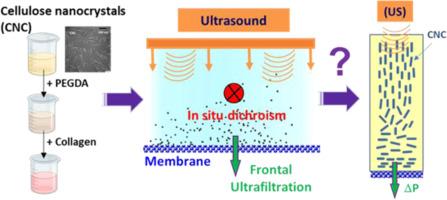CNC/PEGDA/胶原混悬液的液晶行为对其正交各向异性组织的影响
IF 6.5
Q1 CHEMISTRY, APPLIED
Carbohydrate Polymer Technologies and Applications
Pub Date : 2025-09-25
DOI:10.1016/j.carpta.2025.101015
引用次数: 0
摘要
本研究通过正面超滤(FU)和超声(US)的联合作用,探讨了添加生物相关大分子对水介质中已获得的纤维素纳米晶体(CNC)正交各向异性组织保存的影响。特别地,探讨了光固化聚合物聚乙二醇二丙烯酸酯(PEGDA)与水性CNC悬浮液,在80/20重量比[水/PEGDA]和胶原蛋白的影响。流变学和偏振光显微镜测量揭示了悬浮液的液晶行为。在FU/US过程中的原位二色性允许检查正交异性组织的保存。首先,结果证明了液晶样行为对于在FU和US下实现CNC/PEGDA/Collagen悬浮液所期望的正交各向异性取向至关重要。其次,确定声功率和过滤时间是保持正交各向异性排列的关键参数。第三,已经找到了成功实现正交异性结构的特定配方条件:i)不含胶原蛋白,20 wt% PEGDA和5 ~ 8 wt% CNC;ii)酸性pH下的胶原,20 wt% PEGDA, 6 ~ 8 wt% CNC, 0.01 ~ 0.1 mg/mL胶原。这些发现为通过将FU/US工艺与光交联相结合来生产用于组织工程的正交各向异性水凝胶铺平了道路。本文章由计算机程序翻译,如有差异,请以英文原文为准。

Role of liquid crystal behavior of CNC/PEGDA/collagen suspensions on their orthotropic organization obtained by ultrafiltration and ultrasound
This study explored the effect of adding biologically relevant macromolecules on the preservation of cellulose nanocrystal (CNC) orthotropic organization already obtained in aqueous media, via the combined action of frontal ultrafiltration (FU) and ultrasound (US). In particular, the effect of a photocurable polymer poly(ethylene glycol) diacrylate (PEGDA) with aqueous CNC suspension, in 80/20 weight ratio [water/PEGDA] and collagen were explored. Rheometric and polarized light microscopy measurements were used to reveal the liquid crystal behavior of suspensions. In situ dichroism during the FU/US process allowed to examine the conservation of orthotropic organization. First, the results have proved that the liquid crystal-like behavior is essential for achieving the desired orthotropic orientation of CNC/PEGDA/Collagen suspensions under FU and US. Second, acoustic power and filtration time have been identified as key parameters in preserving the orthotropic arrangement. Third, specific formulation conditions have been found to successfully achieved the orthotropic structure: i) without collagen, 20 wt% PEGDA and 5 to 8 wt% CNC; and ii) with collagen at acidic pH, 20 wt% PEGDA, 6 to 8 wt% CNC, and 0.01 to 0.1 mg/mL collagen. These findings pave the way for future investigations to produce orthotropic hydrogels for tissue engineering, by combining FU/US process with photocrosslinking.
求助全文
通过发布文献求助,成功后即可免费获取论文全文。
去求助

 求助内容:
求助内容: 应助结果提醒方式:
应助结果提醒方式:


